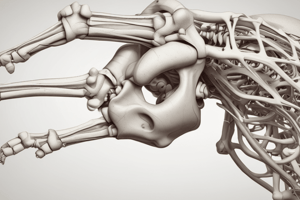Podcast
Questions and Answers
What is the function of the flexor muscles in the anterior compartment?
What is the function of the flexor muscles in the anterior compartment?
- Flex the wrist and fingers (correct)
- Extend the wrist and fingers
- Rotate the forearm so the palm faces upwards
- Control the thumb
Which bone in the forearm is thicker at the proximal end and thinner at the distal end?
Which bone in the forearm is thicker at the proximal end and thinner at the distal end?
- Ulna
- Humerus
- Radius (correct)
- Scapula
What is the function of the supinator muscles in the posterior compartment?
What is the function of the supinator muscles in the posterior compartment?
- Extend the wrist and fingers
- Rotate the forearm so the palm faces upwards (correct)
- Flex the wrist and fingers
- Rotate the forearm so the palm faces downwards
Which nerve supplies the thenar muscles and the lateral aspect of the hand?
Which nerve supplies the thenar muscles and the lateral aspect of the hand?
What is the function of the lumbrical muscles in the anterior compartment?
What is the function of the lumbrical muscles in the anterior compartment?
Which artery runs down the medial aspect of the forearm, supplying the hand?
Which artery runs down the medial aspect of the forearm, supplying the hand?
What is the function of the anconeus muscles in the posterior compartment?
What is the function of the anconeus muscles in the posterior compartment?
What is the purpose of the interosseous membrane?
What is the purpose of the interosseous membrane?
Which structure contains the median nerve, brachial artery, and biceps tendon?
Which structure contains the median nerve, brachial artery, and biceps tendon?
Which bone in the forearm is longer and thinner than the radius?
Which bone in the forearm is longer and thinner than the radius?
Flashcards are hidden until you start studying
Study Notes
Bones
- The forearm consists of two bones:
- Radius: thicker at the proximal end, thinner at the distal end
- Ulna: longer and thinner than the radius, with a larger proximal end and a smaller distal end
Muscles
- Anterior compartment:
- Flexor muscles: flex the wrist and fingers
- Pronator muscles: rotate the forearm so the palm faces downwards
- Thenar muscles: control the thumb
- Hypothenar muscles: control the little finger
- Interosseous muscles: move the fingers
- Lumbrical muscles: flex the fingers
- Posterior compartment:
- Extensor muscles: extend the wrist and fingers
- Supinator muscles: rotate the forearm so the palm faces upwards
- Anconeus muscles: extend the elbow
Arteries
- Radial artery: runs down the lateral aspect of the forearm, supplying the hand
- Ulnar artery: runs down the medial aspect of the forearm, supplying the hand
Nerves
- Median nerve: runs down the anterior compartment, supplying the thenar muscles and the lateral aspect of the hand
- Ulnar nerve: runs down the medial aspect of the forearm, supplying the hypothenar muscles and the medial aspect of the hand
- Radial nerve: runs down the posterior compartment, supplying the extensor muscles and the dorsal aspect of the hand
Other Structures
- Interosseous membrane: a thin sheet of connective tissue between the radius and ulna, providing stability to the forearm
- Cubital fossa: a triangular region at the elbow, containing the median nerve, brachial artery, and biceps tendon
Bones
- Forearm consists of two bones: Radius and Ulna
- Radius: thicker at proximal end, thinner at distal end
- Ulna: longer and thinner than Radius, with larger proximal end and smaller distal end
Muscles
Anterior Compartment
- Flexor muscles: flex wrist and fingers
- Pronator muscles: rotate forearm to face palm downwards
- Thenar muscles: control thumb
- Hypothenar muscles: control little finger
- Interosseous muscles: move fingers
- Lumbrical muscles: flex fingers
Posterior Compartment
- Extensor muscles: extend wrist and fingers
- Supinator muscles: rotate forearm to face palm upwards
- Anconeus muscles: extend elbow
Arteries
- Radial artery: supplies hand, runs down lateral aspect of forearm
- Ulnar artery: supplies hand, runs down medial aspect of forearm
Nerves
- Median nerve: supplies thenar muscles and lateral aspect of hand, runs down anterior compartment
- Ulnar nerve: supplies hypothenar muscles and medial aspect of hand, runs down medial aspect of forearm
- Radial nerve: supplies extensor muscles and dorsal aspect of hand, runs down posterior compartment
Other Structures
- Interosseous membrane: thin sheet of connective tissue between Radius and Ulna, provides stability to forearm
- Cubital fossa: triangular region at elbow, contains median nerve, brachial artery, and biceps tendon
Studying That Suits You
Use AI to generate personalized quizzes and flashcards to suit your learning preferences.




